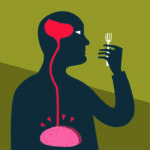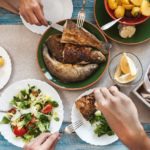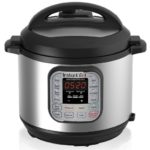
Natalie Digate Muth, MD, MPH, RD
Natalie Digate Muth, MD, MPH, RD
Article Archive
The U.S. Department of Agriculture will retire SuperTracker on June 30. SuperTracker is a free online nutrition, goal-tracking and food analysis tool, which more than 27 million people have used since its launch in 2011. The USDA says many other private nutrition tools are readily available and that it would like to spend its resources finding more efficient and modern ways to “help Americans find an eating style that is right for them.”
Read MoreResearchers are just beginning to understand why weight loss maintenance is so difficult. We know that at least part of the answer lies in metabolic changes that often accompany weight loss. For example, studies show that after diet-induced weight loss, the hunger hormone ghrelin increases, while satiety decreases amid declining levels of hormones such as peptide YY and glucagon-like peptide-1. After exercise-induced weight loss, hunger hormones also rise, but some studies suggest that satiety climbs as well.
Read MoreThe current administration appears determined to weaken federal nutrition policy:
Read MoreFor generations, pediatricians have recommended rice cereal as a first food for babies in the transition to eating solids. Rice cereal is easy for babies to eat and is high in iron, an important nutrient for growing brains. However, recent research cited in Consumer Reports found persistently high levels of arsenic in rice and rice products, including infant rice cereal.
Rice tends to absorb more arsenic than other grains mostly because it is grown in water-flooded soil.
The thirst for sugary drinks remains strong in all U.S. populations despite multiple health risks. However, moms-to-be have a new reason to decrease (or better, eliminate) sugary drinks during their pregnancies. A new study in Annals of the American Thoracic Society suggests that limiting intake of sweetened beverages may lower babies’ asthma risk in childhood (in addition to reducing the risk of obesity).
Read MoreA Scientific Reports study of Chinese schoolchildren found that those who said they ate fish at least twice a week when aged 9–11 slept better and longer and had IQs nearly 5 points higher when they were 12 than children who ate no fish. The authors suggested the higher IQs could be mediated through better-quality sleep. This study adds to a body of science demonstrating strong relationships between fish intake, health and quality of life for kids and adults alike.
Read MoreEggs belong on the shortlist of superfoods. Costing just about 15 cents each for some brands, they are loaded with high-quality protein and many other nutrients. For athletes, especially those involved in resistance training, egg protein is particularly valuable for increasing muscle protein synthesis.
Read MoreLooking for new nutrition tools and resources to share with clients? MyPlate has launched seasonal resources for nutrition and health professionals to share with clients. Jump into spring with gardening resources and ideas for using homegrown herbs in cooking, and sample Earth Day activities, farmers’ market resources, and tips for prepping potlucks and parties.
Learn more at choosemyplate.gov/seasonal.
Female team athletes may need more protein for optimal recovery than previous research has suggested, according to a new study published in Medicine & Science in Sports & Exercise, the American College of Sports Medicine’s flagship journal. This study looked at six women engaging in variable-intensity intermittent exercise, the activity style common to most team sports.
Read MoreFor decades researchers have sought to find the best diet to help people achieve the elusive goal of permanent weight loss. In the context of a worsening obesity epidemic and massive efforts underway to attempt to curb it, health professionals and the public are hungry for an answer. What diet will best help us improve the weight and health status of the most people?
Read MoreNext time you’re playing a game, hiking, working out at the gym or going for a walk, think about vacuum-insulated water bottles. They can boost hydration by keeping water cold and refreshing for up to 24 hours, and they’ll keep hot drinks hot for up to 5–6 hours. The bottles work this magic by including two chambers: a water compartment and surrounding vacuum-channel insulation. Meeting requirements for style, function and eco-friendliness, these vacuum-insulated water bottles offer a fun, effective way to hydrate.
Read MoreThe food industry has an inherent conflict of interest when it funds
nutrition research. After all, food manufacturers’ livelihoods rise and fall on how we decide to consume calories. The industry’s deep pockets translate into influence over dietary experts, scientific studies and nutrition policymakers.
Thinking of starting a nutrition or healthy-eating blog? Start by knowing the data on what end users find most useful.
Read MoreHumans are hardwired to resist dietary restrictions. Science bears this out: In the absence of an ongoing weight maintenance program, half of the people who lose 10% or more of body weight gain it all back within 5 years or so (Montesi et al. 2016).
Read MoreIf you’re anything like one of our editors, who has vivid memories of tomato sauce dripping from the kitchen ceiling after her mom’s 1970s pressure cooker exploded, you might be a little fearful of jumping on the pressure cooker bandwagon. But chances are good that, if you do, you won’t regret it (don’t worry—pressure cookers these days have safety valves to help prevent explosions). These kitchen contraptions are making a comeback due to their unmatched power to put a delicious dinner on the table in no time. Pressure cookers work by heating up food rapidly in a sealed pot.
Read MoreEvery 5 years, the U.S. Department of Health and Human Services and the U.S. Department of Agriculture update the Dietary Guidelines for Americans. A scientific advisory committee is recruited and installed in the 2 years before the DGA are released. This committee reviews the nutrition literature and provides nonbinding recommendations to the federal government. The committee’s report is posted publicly and is open to public comment.
Read MoreThe gluten-free movement leaves researchers, clinicians and nutrition professionals with many unanswered questions, especially how to best help those who do not have celiac disease—an autoimmune ailment linking gluten to severe intestinal damage—but experience similar symptoms.
Read MoreThe best method for helping someone make healthier nutrition choices goes beyond providing nutrition education and reciting key points from the Dietary Guidelines for Americans. It includes helping people develop the skills needed to translate information into real life—that is, living the DGA.
Read MoreDespite more than a decade of intensive efforts to reverse the adult and childhood obesity crises, obesity remains widespread. Generally, the first treatment recommendation is to lose weight, but losing large amounts of weight and keeping it off is difficult, and possibly not even the best reflection of health improvements. After all, the number on a scale is just one measure of health.
Read MoreAuthors of a recent viewpoint published in the prestigious Journal of the American Medical Association issued a call for clinicians to incorporate more nutrition counseling into their patient interactions to better help people improve health outcomes. The authors noted that our changing healthcare system offers clinicians more opportunities to engage patients in nutrition counseling, though few do.
Read More















-150x150.png)


